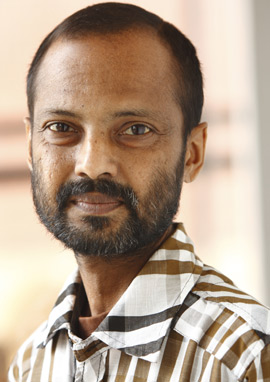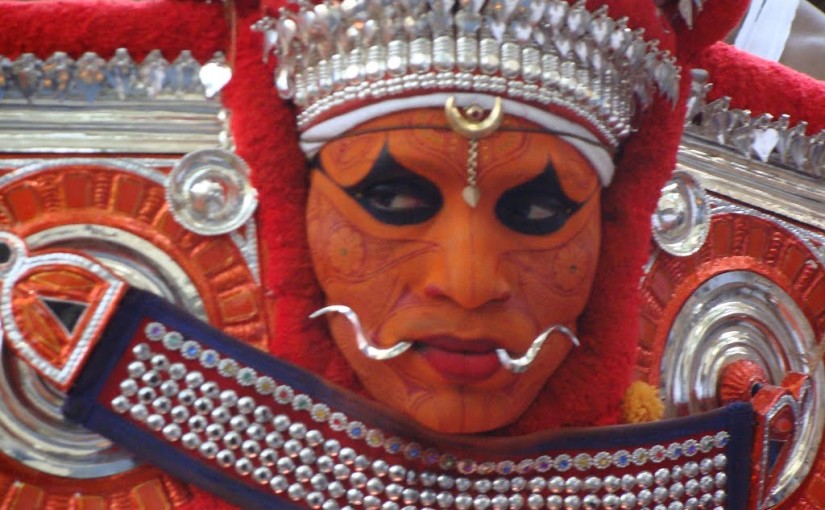(Photo and Introduction Text courtesy: Mathrubhumi Online)
{{ Mathrubhumi `Star & Style’ chief sub editor and short story writer K V Anoop (42) passed away at a private hospital here around 11 am on Monday, September 14 2014.
Anoop was born on April 25, 1972 and joined Mathrubhumi in 1997 as sub editor. His literary works include Anandapathuvinte Prasangangal, Kazhchakkulla Vibhavangal (collection of short stories), Ammadeivangalude Bhoomi (novel), Maradona: Deivam, Chekuthan, Rakthasakshi (a biography) and Lionel Messi: Tharodayathinte Kadha.
His novel Ammadeivangalude Bhoomi won the Uroob award way back in 1992. He is also a recipient of Muttathu Varkey Foundation award (1994), Ankanam-E P Sushama Memorial Endowment (2006) and Mundoor Krishnankutty award (2011).
Anup and I studied together at Govt Boys High School, Pallur, Mahe}}
പള്ളൂര് റോഡിലെ വലിയ കയറ്റo കയറി കിതച്ചോടി ഹൈസ്കൂലെത്തുബോള്, മിഡില് സ്കൂലിന്റെ ലയo മാറാത്ത ഒരെട്ടാo ക്ലാസൂകരനായിരുന്നു ഞാന്. അവിടെ, മാഹിക്കു പുറത്തു നിന്ന് ആദ്യമായ് എനിക്കു കിട്ടിയ ചങ്ങാതി: അനൂപ്. ഒരു ആറാം ക്ലാസുകാരെന്റെ രൂപം. പതിഞ്ഞ, ദ്യെഷ്യo വരുമ്പോളും ഖരം പകരാത്ത ശബ്ദം. എം ടിയുo, ഉറൂബുo, മുകുന്ദനും, കാക്കനാടനും, ചുള്ളിക്കാടു ഒക്കെയായി, പഴയ സ്കൂലിന്റ്റെ കെട്ടിടങ്ങള്ക്ക് ഇടയിലെ പോളിഞു കീറിയ വഴികളില് എഴുത്തിന്റ്റെ അറിയാ വഴികളില്, പി. ടി പിരീടുകളില് അലഞ നാളുകള്!. ( അന്ന് പി. ടി പിരീടുകളെ ഒഴിച്ചു നിര്ത്തിയ ആള്, പിന്നെങ്ങനെ മറഡോണയുടേയും, മെസ്സിയുടെയും ജീവിത കഥയില് എത്തിപ്പെട്ടെന്ന് ഞാന് അത്ഭുതപെട്ടിടുണ്ട്!)
അങ്ങിനെ ഒരു ദിവസം കിട്ടിയ “വലിയ” ആശയം ആയിരുന്നു : പള്ളൂര് സ്ക്കൂളിനായായൊരു കൈയ്യെഴുത്തു മാസിക. ലിറ്റില് മാഗസിനുകളുടെ പ്രഭാവ കാലം അസ്തമിച്ചു കൊണ്ടിരുന്ന എമ്പത്തുകളുടെ അവസാനകാലം, പ്രിന്റ് ചെയ്യാന് പൈസയില്ലാതിരുന്ന ഞങ്ങള്, ഒരു കൈയ്യെഴുത്തു മാസിക ഉണ്ടാക്കി. മാഗസിന് നിറക്കാന് കൃതികള് തേടി അറിയുന്ന ക്ലാസിലെല്ലാം കേറിയിറങ്ങി. തികയാതെ വന്നപ്പോള് അനൂപ് തന്നെ ഒന്ന് രണ്ടു കഥകളും കവിതകളും എഴുതി. മാഗസിന്റെ സൈഡ് ബോക്സുകളില് ഞങ്ങള് മനോധര്മം നിറച്ചു. എഴുത്തായിരുന്നു, കൃതി എഴുതല്ല, പകര്ത്തെഴുതായിരുന്നു, ഏറ്റവും ബോറടിച്ച പണി. കറുത്ത മഴിയില്, പാതി വെളുത്ത നീളന് കടലാസ്സില്, അനൂപിന്റെ, ഇരുണ്ടു വടിവാര്ന്ന കൈയ്യക്ഷരം ഞങ്ങളിലെ യുവ സാഹിത്യകാരന്മാരുടെ കൃതികള്ക്ക് രൂപം നല്കി: ഓപ്പം അവന്റെ വര്ണ ചിത്രങ്ങളും. മാഗസിന്റെ തുടക്കo ബാല്റാo മാഷുടെ ആമുഖ കുറിപ്പോടെ. അനൂപ് തുണിപിടിപ്പിച്ചു മനോഹരമാക്കിയ മാസിക ( ഒരിക്കലേ അതു പുറത്തു വന്നുള്ളൂ!), ബല്റാo മാഷ്ക്ക് കാണിച്ചപ്പോള്, ചിരിക്കാന് പിശുക്കുള്ള മാഷുടെ പുഞ്ചിരിയില് ഞങ്ങള് എത്ര തന്നെ സന്തോഷിച്ചില്ല!
ഹൈസ്കൂളിലെ വെളിച്ചമിറങ്ങാത്ത ലൈബ്രറി മുറിയിലെവിടയോ അനൂപിന്റെ ആ ആദ്യ പ്രസിഡീകരണം ഇപ്പഴും ജീവിച്ചിരിപ്പുണ്ടാവാo…. പറയാന് ബാക്കിവെച്ച കഥകളും,നോവലുകളും ആ മഴി പുരണ്ട താളുകളിലെവിടെയോ അനൂപിനെ തേടുന്നുണ്ടാവാം….


 Book Review: The Geography of Bliss: One Grump’s Search for the Happiest Places in the World by Eric Weiner
Book Review: The Geography of Bliss: One Grump’s Search for the Happiest Places in the World by Eric Weiner Making Your Case: The Art of Persuading Judges, by Antonin Scalia
Making Your Case: The Art of Persuading Judges, by Antonin Scalia